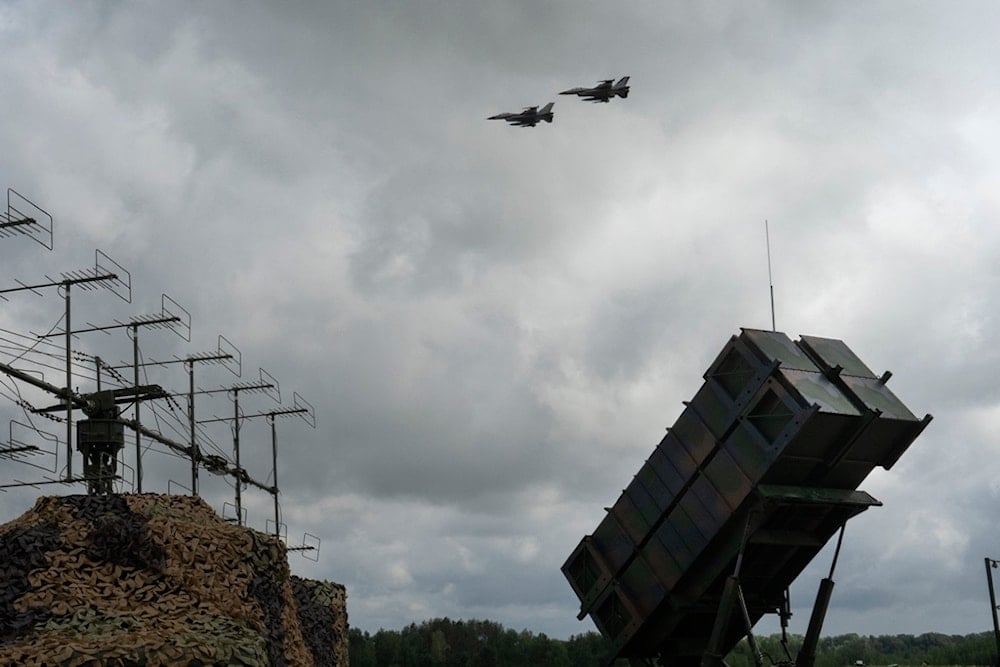US moves Patriot, THAAD systems to Middle East amid tensions in region
The timing of the relocation is particularly notable, as it coincides with what South Korea and the US have acknowledged as heightened security threats from the Democratic People's Republic of Korea.
-
 The Ukrainian Air Force's F-16 fighter jets fly over a Patriot Air and Missile Defense System in an undisclosed location in Ukraine, Sunday, Aug. 4, 2024 (AP)
The Ukrainian Air Force's F-16 fighter jets fly over a Patriot Air and Missile Defense System in an undisclosed location in Ukraine, Sunday, Aug. 4, 2024 (AP)
The United States is redeploying its Patriot missile defense batteries from the Indo-Pacific region to the Middle East in what is being described as a major and unprecedented military mobilization.
According to South Korea’s Yonhap News Agency, which cited unnamed sources, the US and South Korea agreed last month to a “months-long” deployment of the Patriot Advanced Capability-3 (PAC-3) system from South Korea to the Middle East. This marks the first known instance of US Forces Korea (USFK) equipment being transferred to the region.
Previously, NBC News reported that US Defense Secretary Pete Hegseth had approved the relocation of at least two Patriot batteries and a Terminal High Altitude Area Defense (THAAD) system from Asia to the Middle East.
The timing of the relocation is particularly notable, as it coincides with what South Korea and the US have acknowledged as heightened security threats from the Democratic People's Republic of Korea (DPRK). In South Korea, the Patriots are part of a multilayered missile defense shield against Pyongyang’s nuclear and missile capabilities.
This redeployment also aligns with broader military movements in the Middle East. Last month, Hegseth ordered the Nimitz-class aircraft carrier USS Carl Vinson to leave the Indo-Pacific and head to the Middle East, while the deployment of the USS Harry S. Truman in the region was extended. The US has also stationed multiple aerial refueling tankers, transport aircraft, and at least six B-2 stealth bombers at its base on Diego Garcia, a British territory in the Indian Ocean.
Dubbed “ghosts of the sky,” these stealth bombers are capable of breaching advanced air defenses and delivering precise, high-impact strikes. While these military assets were initially thought to be directed at escalating operations against the Yemeni Armed Forces, they now appear to be part of a strategy aimed at Iran.
On March 30, US President Donald Trump issued Iran a two-month ultimatum to reach a nuclear agreement with Washington. Speaking to NBC News’ Kristen Welker, Trump warned, “If they don’t make a deal, there will be bombing. It will be bombing the likes of which they have never seen before.”
Tehran has rejected direct talks, citing ongoing US threats and Trump's “maximum pressure” policy. However, Iranian President Masoud Pezeshkian stated that indirect negotiations remain possible.
Sources quoted by Iranian media claim Trump has asked Iran to cease the development of drones and missiles, cut ties with regional Resistance groups, and completely dismantle its nuclear program, demands Tehran has labeled excessive, according to EurAsian Times.
In response to Trump’s threats, the Leader of the Islamic Revolution, Sayyed Ali Khamenei, has vowed that the US would "certainly receive a heavy blow" in the event of a strike against Iran.
EurAsian Times cited Iranian media reports suggesting the country’s missile forces have been placed on high alert, with launch-ready weapons housed in underground facilities. Iran’s General Staff has also affirmed that Tehran "has achieved a level of active deterrence in which any violation of its sovereignty will be met with a severe response.”
The news website suggested that there is growing speculation that Iran and its allies could target US bomber assets at Diego Garcia if conflict erupts.
It also pointed out that it remains unclear whether the US intends to initiate large-scale military action against Iran or if this is a strategy of "brinkmanship" designed to pressure Tehran, adding that either way, the stakes are high, and enhancing US air defense capabilities in the Middle East appears to be a precautionary response to potential conflict.
Why the Patriot system?
EurAsian Times noted that the Patriot system is a mobile, ground-based interceptor designed to detect, track, and engage cruise missiles, short-range or tactical ballistic missiles, aircraft, and unmanned aerial vehicles.
A standard Patriot battery includes the AN/MPQ-65 phased array radar, fire control systems, communication units, support vehicles, and up to eight trailer-mounted launchers. The latest variants can deploy the full range of Patriot missiles, including PAC-3 interceptors.
The news website mentioned that the system gained prominence during the Ukraine war, where it reportedly intercepted Russian hypersonic missiles, which are difficult to counter due to their speed and unpredictable flight paths. Patriot systems were also credited with downing several Russian Su-34 bombers.
Given its capabilities, the Patriot system could counter Iran’s Fattah-1 hypersonic missiles, should they be deployed, according to EurAsian Times. Its agile, narrow radar beam allows it to track low radar-cross-section targets, including stealth aircraft, cruise missiles, and ballistic missiles.
The news website highlighted that the upgraded PAC-3 variant is designed to intercept threats below 40 kilometers in altitude. The PAC-3 Missile Segment Enhancement (MSE) is a high-velocity, hit-to-kill missile that uses a fragmentation warhead to neutralize its targets.
NBC’s earlier report also mentioned the redeployment of a THAAD system to the Middle East, which would complement the Patriot batteries. The system is designed to intercept ballistic missiles during their mid-course and terminal phases using a kinetic kill approach.
A full THAAD battery consists of six launchers, an AN/TPY-2 radar, fire-control systems, and supporting units. Its radar can detect missile launches from 1,500 to 2,000 kilometers away and integrates with other sensors, such as satellites and Aegis systems, for broader coverage. THAAD works in conjunction with the PAC-3 and the US military’s Command, Control, Battle Management, and Communications (C2BMC) system.
Regarded as the most advanced US missile defense platform, THAAD has been stationed in "Israel" since December 2024 amid similar fears of an Iranian missile strike.
Read more: New US destroyer spotted near Indian Ocean base amid rising tensions

 6 Min Read
6 Min Read










